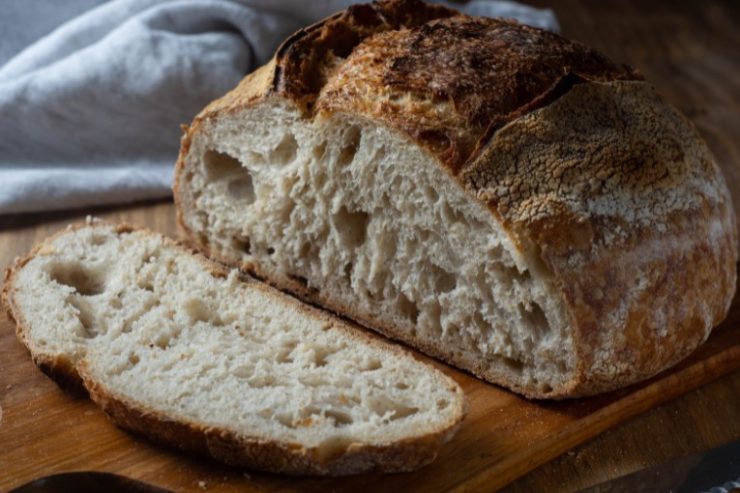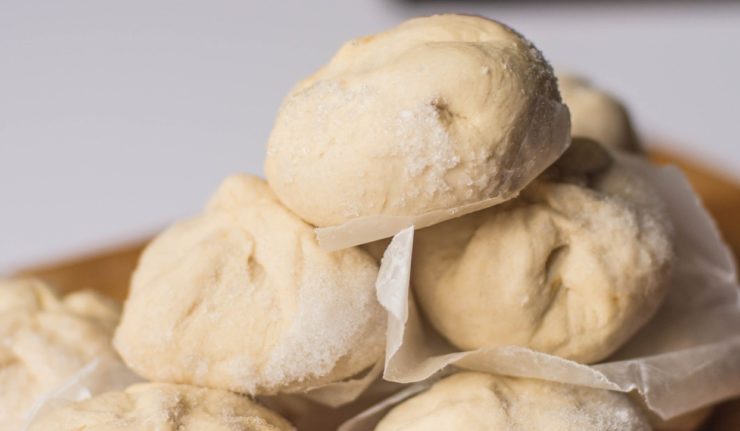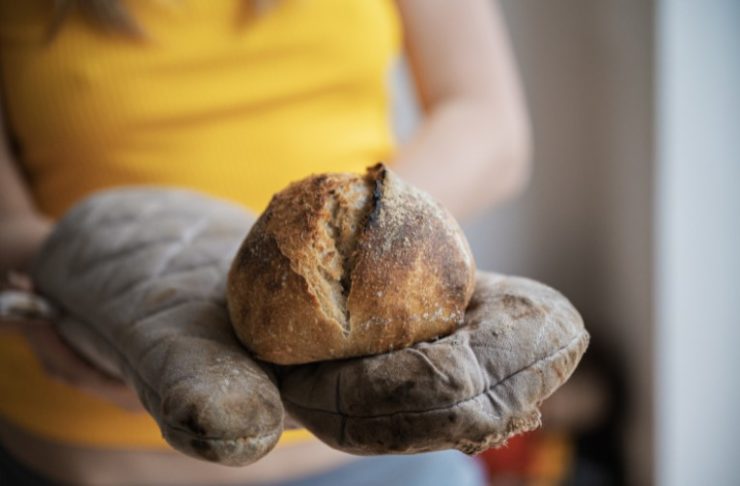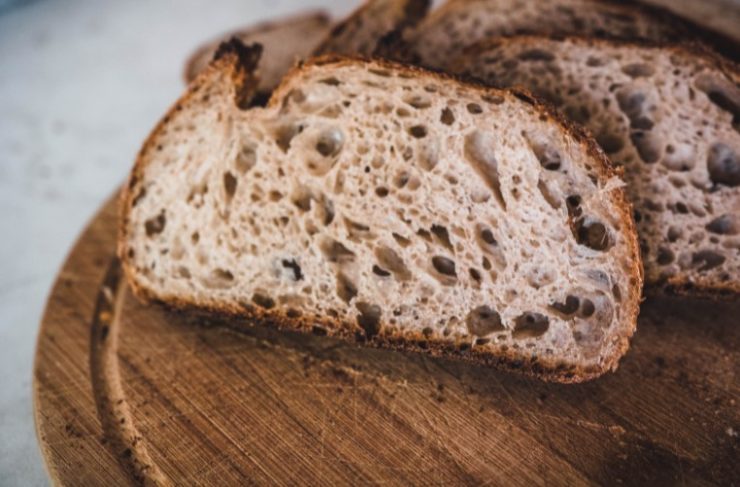Sourdough bread is one of those magical foods that taste so much better than the sum of its parts. After all, it’s made from just flour, water, and salt.
And no matter if you bake your own or buy it from a bakery, it seems like a race against the clock to eat it before it becomes dry and stale.
In general, a loaf of sourdough bread is good for around 5 days, and is always at its best on day 1. But, even if you miss your 5-day window, all is not lost.
With years of professional and home baking experience, I’ll walk you through how long sourdough bread is good for, how to extend its shelf life, and what to do if you just can’t eat it fast enough.
Whatever you do, please read this before resorting to the trash.
In This Article
How To Store Sourdough Bread

Depending on what stage of life your bread is in will determine how best to store it.
When bread has just been baked and is on the first day of its new life outside of the oven, it should be stored at room temperature. Either unwrapped or loosely wrapped in paper or a breathable towel.
If you bake your own bread (bravo!) this is especially important for the first few hours after it comes out of the oven. Freshly baked bread can take a long time to thoroughly cool, and all the while it’s rapidly releasing moisture.
If you wrap your bread or place it in a container before it’s FULLY cooled, you’re likely to end up with a soggy exterior rather than the beautiful, crispy, chewy crust that you worked so hard for.
If you buy sourdough fresh from a bakery, the same rules apply.
Freshly baked sourdough can be left out either until you cut into it, or when you’re turning in for the night. But always after it’s completely cooled.
Once you cut into your sourdough, or you have it sliced at the bakery, it will quickly begin to dry on the inside, which means it’s time to wrap or bag.
At this stage (as long as it’s completely cooled) your bread should be tightly wrapped in plastic or placed in a plastic bag or air-tight container.
Sourdough is never better than the day it was baked. And after it’s been wrapped or bagged, you should store it at room temperature and consume it within 5 days.
Just know that once you wrap or bag your bread, you’ll lose your crisp crust pretty quickly.
As long as you don’t see any mold forming, you can certainly eat your sourdough past the 5-day mark, but beware that it will become increasingly dry and stale.
If the loaf gets too hard and stale, french toast might be in order.
Things That Can Shorten The Shelf Life Of Bread

Buying or having your sourdough sliced at the bakery is incredibly convenient. And if you know you’ll be using the loaf for sandwiches, then by all means. But, sliced bread will become dry and stale significantly faster than whole loaves.
Sliced sourdough should really be used within 2 or 3 days.
Even if it’s stored in a plastic bag, there is much more surface area that leads to it quickly drying out. Once again, french toast to the rescue.
It’s also best to keep fresh sourdough at room temperature (unless you’re going to freeze it) rather than in the fridge. While it may seem like the fridge would keep the bread moist for longer, it will actually cause it to go stale very rapidly.
To Freeze Or Not To Freeze

Definitely to freeze. If you know you won’t be eating your sourdough within a few days or a week, your best bet is the freezer.
Again, it’s important to make sure your bread is completely cooled first.
Once it has cooled, you can tightly wrap it in a couple of layers of plastic, or place it in a zip-top bag before it goes into the freeze. You can do this with whole loaves, half loaves, or even slices.
If you go the sliced route, you might try placing a small piece of parchment between each piece to keep the slices from sticking together. It makes it much easier if you’ll be using a slice or two at a time.
Frozen slices can be toasted as is, no need to defrost. And whole loaves bake up almost as good as new.
If you need a loaf quickly, spritz lightly with water and toss it in a 325 F oven for between 20-30 minutes.
When wrapped or bagged and frozen properly, sourdough will easily last for 3 months or longer.
How To Refresh Bread That’s Going Stale

If your sourdough is a little past its prime, there’s no need to fear.
Just like when reheating frozen bread, a stale loaf just needs a little extra moisture and heat.
I like to use a spray bottle or a spritz with my fingers, but you’re really just looking to get the exterior of the bread damp. You can even briefly run your loaf directly under the faucet, just try not to saturate the insides.
Then, place the loaf directly on the rack of a 325 F oven for around 10-15 minutes. If it’s a half loaf or any other portion with a cut side, cover the open area with a piece of foil to keep that part from becoming overly dry, and check it after around 7 minutes.
Does Sourdough Go “Bad” Faster Than Other Types of Bread?

Sourdough bread won’t go bad any faster than any other type of bread without preservatives.
As we already talked about, sourdough bread can easily become dry and stale, but that’s no reason to throw it out.
However, if you notice that your bread has visible mold or an off smell or taste, it’s time to cut your losses.
Don’t Let Old Sourdough Go To Waste

I’ve worked in many restaurants that bake and serve their own bread. And when guests are paying top dollar, you simply can’t serve them day-old bread.
Luckily, there are plenty of ways to utilize extra bread so that all of that hard work and food doesn’t end up in the trash.
The number one use for extra bread in professional kitchens; quelling the hunger of the front-of-house staff. Ok, maybe not the most useful suggestion for at home.
Here are some other easy and useful ideas for dry or stale sourdough bread.
- Bread crumbs
- Croutons
- Panzanella salad
- French toast (can you tell I like french toast)
- Bread pudding
- Stuffing
Frequently Asked Questions
Does Sourdough Bread Go Bad?
Sourdough bread can get dry, stale, or moldy just like any other bread.
How Do You Know If Sourdough Bread Has Gone Bad?
Dry or stale sourdough bread can still be safely eaten, but if you notice any mold, or an off taste or smell, it should be thrown out.
How Should You Store Sourdough Bread?
Sourdough bread should be stored uncovered, at room temperature on the first day it is baked. After that, it should be wrapped in plastic or stored in an airtight container, still at room temperature. Sourdough can also be frozen after it’s been completely cooled and wrapped in plastic or in a zip-top bag.







